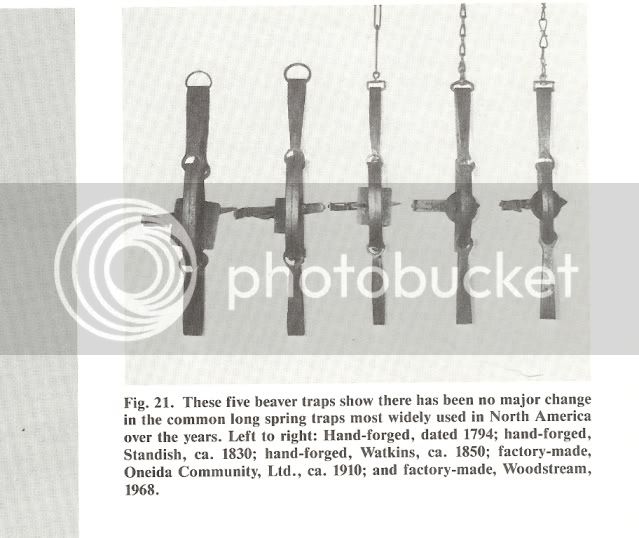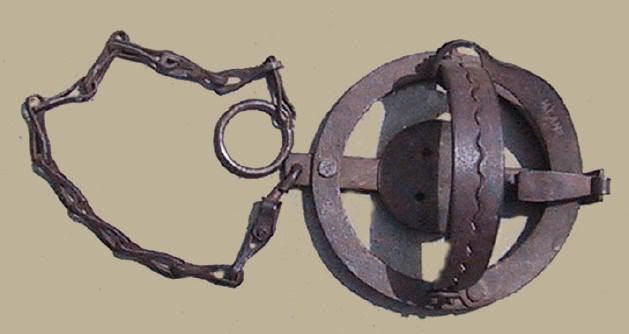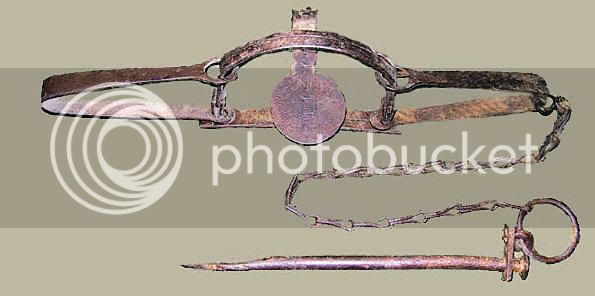You are using an out of date browser. It may not display this or other websites correctly.
You should upgrade or use an alternative browser.
You should upgrade or use an alternative browser.
Back dating old Victor traps?
- Thread starter pichou
- Start date

Help Support Muzzleloading Forum:
This site may earn a commission from merchant affiliate
links, including eBay, Amazon, and others.
Rod Lassey
50 Cal.
- Joined
- Sep 5, 2007
- Messages
- 1,418
- Reaction score
- 11
I've never tried working over the trap itself--I have fitted Victors with forged link chain and swivels, which adds weight and does help with the look--somewhat.
I've got several old Newhouse traps, which are much closer in looks to the lighter style HBC trap. They've got the Y-shaped jaw hinges, for instance. But, those old Newhouses are rapidly becoming collector items themselves, and are getting pricey.
Rod
I've got several old Newhouse traps, which are much closer in looks to the lighter style HBC trap. They've got the Y-shaped jaw hinges, for instance. But, those old Newhouses are rapidly becoming collector items themselves, and are getting pricey.
Rod
Well, I figured out a few things.
Square pan, new cross and dog, and new chain.
Here is a #4 (not that old) with a riveted square pan. I think the rest can wait, but a different chain would help.

Getting rid of that round pan with the cutout V really helps the look.
Square pan, new cross and dog, and new chain.
Here is a #4 (not that old) with a riveted square pan. I think the rest can wait, but a different chain would help.

Getting rid of that round pan with the cutout V really helps the look.
T.C.Albert
40 Cal.
- Joined
- Apr 16, 2007
- Messages
- 220
- Reaction score
- 0
On the old traps, didnt the jaws attach to the frame on a yoke that actually was bolted to the trap frame with a square nut? That was seen on alot of the hand made traps and was still a design feature on the Onida and Newhouse pre-Victor #4s I think...
TCA
TCA
The yoke is a old time thing, with big square nuts. But before that, some had just a bend with holes, like the Victor.
I'm going to try to copy the muskrat trap in The Voyageur's Sketchbook. It has a flat single spring, and no yokes.
I hear there is a beaver trap in The Mountain Man Sketchbook V. 2... but I don't have that.
I'm going to try to copy the muskrat trap in The Voyageur's Sketchbook. It has a flat single spring, and no yokes.
I hear there is a beaver trap in The Mountain Man Sketchbook V. 2... but I don't have that.
The Longhunter Sketchbook has an early beaver trap drawn in it. Hanson says: THis it the earliest know American-made trap. The son of the maker was a noted riflesmith in Bucks County, Pennsylvania. The bottom of the trap was engraved in script -- George Weicker 1760.
It is very similar to the muskrat trap shown in the Voyageur's Sketchbook, but about twice the size and the spring was riveted on in the opposite direction and then looped back over to the trap jaws.
The Mountain Man Sketchbook Vol. 2 shows two beaver traps one dated to 1809 and the other to between 1820 and 1840. They are both double spring, with the springs having loops on both ends so they can swivel. The jaws are both attached to that Y yoke which is bolted on the one and with a wedge pin on the other. On the 1809 the cross bar for the trigger mechanism is forged as one piece with the bottom trap bar. The other one is riveted on.
The main indication I have seen for having the end of the bottom trap bar being bent up and punched for the trap jaws is the SIZE of the trap. The bent up ends are more for the smaller traps. But I do have one original European (Spanish) trap that does have the end bent up for the jaws to loop through, with the other end of the jaws in a Y yoke riveted to the base. But on this one, that bottom also extends out to form the whole spring - being looped completely back.
One note on the FIXED SPRING versions of the traps: when you form the top eye of the spring, it needs to be 3 or 4 times the size/length of the loop on normal traps. Since the spring does not swivel or flex, you need that extra length of opening in the spring end to be able to slid up and down around the trap jaws. With regular style springs, the whole spring can flex up and down to allow that opening to slide up/down the jaws.
The one original European ROUND-BASE trap I have is also a beaver/wolf size. The jaws are tapered/bent through tabs riveted to the base. And the spring is also riveted to that base along with the one jaw tab.
So for muskrat sized traps, there is little problem with bending the end of the base up for the jaws to loop through on the one end. Just be sure that the loop opening on the end of the spring is as least 3 times as long as you think you need - when using a spring riveted to the base.
Just a few humble thoughts to share.
Mikey - that grumpy ol' German blacksmith out in the Hinterlands
It is very similar to the muskrat trap shown in the Voyageur's Sketchbook, but about twice the size and the spring was riveted on in the opposite direction and then looped back over to the trap jaws.
The Mountain Man Sketchbook Vol. 2 shows two beaver traps one dated to 1809 and the other to between 1820 and 1840. They are both double spring, with the springs having loops on both ends so they can swivel. The jaws are both attached to that Y yoke which is bolted on the one and with a wedge pin on the other. On the 1809 the cross bar for the trigger mechanism is forged as one piece with the bottom trap bar. The other one is riveted on.
The main indication I have seen for having the end of the bottom trap bar being bent up and punched for the trap jaws is the SIZE of the trap. The bent up ends are more for the smaller traps. But I do have one original European (Spanish) trap that does have the end bent up for the jaws to loop through, with the other end of the jaws in a Y yoke riveted to the base. But on this one, that bottom also extends out to form the whole spring - being looped completely back.
One note on the FIXED SPRING versions of the traps: when you form the top eye of the spring, it needs to be 3 or 4 times the size/length of the loop on normal traps. Since the spring does not swivel or flex, you need that extra length of opening in the spring end to be able to slid up and down around the trap jaws. With regular style springs, the whole spring can flex up and down to allow that opening to slide up/down the jaws.
The one original European ROUND-BASE trap I have is also a beaver/wolf size. The jaws are tapered/bent through tabs riveted to the base. And the spring is also riveted to that base along with the one jaw tab.
So for muskrat sized traps, there is little problem with bending the end of the base up for the jaws to loop through on the one end. Just be sure that the loop opening on the end of the spring is as least 3 times as long as you think you need - when using a spring riveted to the base.
Just a few humble thoughts to share.
Mikey - that grumpy ol' German blacksmith out in the Hinterlands
Thanks Mike, that is really good info. I was wondering why the spring opening was so big.
I notice Hanson calls the muskrat trap "English style." I do have images of a double fixed spring beaver trap... but can't tell if it has yokes or not. It is Canadian.
I notice Hanson calls the muskrat trap "English style." I do have images of a double fixed spring beaver trap... but can't tell if it has yokes or not. It is Canadian.
Some times the traps with a flat piece of metal on the bottom and a piece above which is the spring, are called Engilsh traps much like what you have only at the bend the top piece would be the springand the bottopm part of the frame.
Pichou if you want some old traps to "restore' drop me a PM with an address to send them to I still have some that I never got around to trestoring when I was collecting traps years ago, you can have them if you are interested.
Pichou if you want some old traps to "restore' drop me a PM with an address to send them to I still have some that I never got around to trestoring when I was collecting traps years ago, you can have them if you are interested.
Rod Lassey
50 Cal.
- Joined
- Sep 5, 2007
- Messages
- 1,418
- Reaction score
- 11
Ahhh....the common English gin. And no, not the stuff you drink...elixar of the gods, in my opinion.....but rather the common English rat trap. These were used for trapping rats, Norway rats, to be specific, but were found to be just the thing for muskrats as well. Single sprung, with either a flat spring riveted to the base, or a V-spring, sometimes with the Y-post, but quite often with the jaws just pivoting in holes in the upturned base. As Mike mentioned, quite often they'd have one end of the jaws pivot in the upturned base, while the other end of the jaws had a Y-post. There's alot of different ways to make these. They should be much easier to rework from a modern trap than the larger beaver traps, as the manufacturing style hasn't changed quite so much.
Changing the pan, and rechaining a modern single spring muskrat trap will be pretty close. One thing about a V-spring, as well, is that they are easier to use in a set. You can 'crook' the set spring over to 75 to 85 degrees in relation to the base, so it will sit better in the set. Same goes for beaver traps. I can imagine the difficulty using the beaver trap that Isham illustrates up at Hudson's Bay--the thing would be about three feet long! Try setting that under a slide---I'd think the only way to use it would be set lengthwise in a breached dam set.
Rod
Changing the pan, and rechaining a modern single spring muskrat trap will be pretty close. One thing about a V-spring, as well, is that they are easier to use in a set. You can 'crook' the set spring over to 75 to 85 degrees in relation to the base, so it will sit better in the set. Same goes for beaver traps. I can imagine the difficulty using the beaver trap that Isham illustrates up at Hudson's Bay--the thing would be about three feet long! Try setting that under a slide---I'd think the only way to use it would be set lengthwise in a breached dam set.
Rod
here are scans of both traps..Pichou said:I hear there is a beaver trap in The Mountain Man Sketchbook V. 2... but I don't have that.
1809 Handforged Trap
Standish Commercial
Here are five traps that date from 1794-1968 this basic style has been around for a long time, I wish they would have shown the traps profile it would have shown the progression of spring,pan,and cross attatchment methods over the years.


- Joined
- Mar 16, 2007
- Messages
- 519
- Reaction score
- 227
These are fairly common chains for up-to-beaver-size traps. In the Newhouse community, the kids made all the trap chain after school.




Drawings from the 17th century show simple oval chain links this was likely the norm for the hand forged trap era, check your library for "The Steel Trap In North America" by Richatrd Gerstell
ISBN 0-8117-1698-8
The first part has some things I think you would like to read and see the pics and drawings.
ISBN 0-8117-1698-8
The first part has some things I think you would like to read and see the pics and drawings.
- Joined
- Mar 16, 2007
- Messages
- 519
- Reaction score
- 227
In my post, Newhouse Community should be Oneida Community. :redface:
Similar threads
- Replies
- 3
- Views
- 722
- Replies
- 0
- Views
- 337
- Replies
- 17
- Views
- 1K
- Replies
- 8
- Views
- 446




